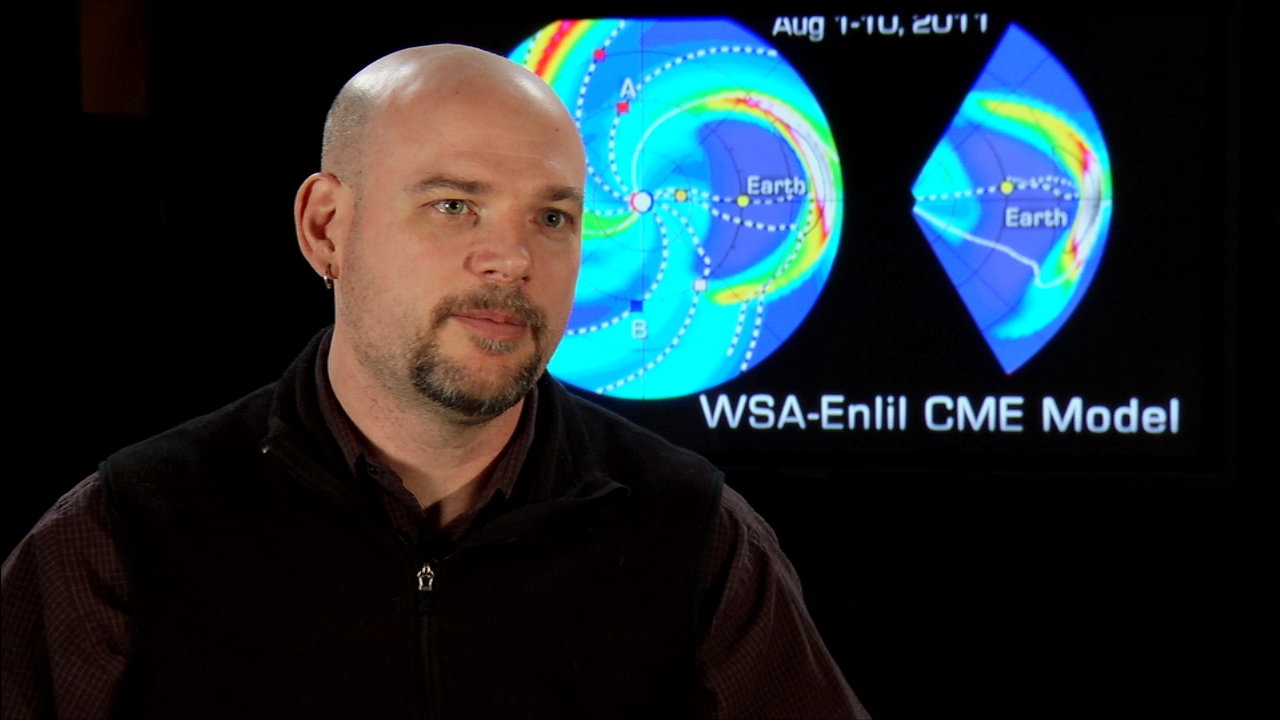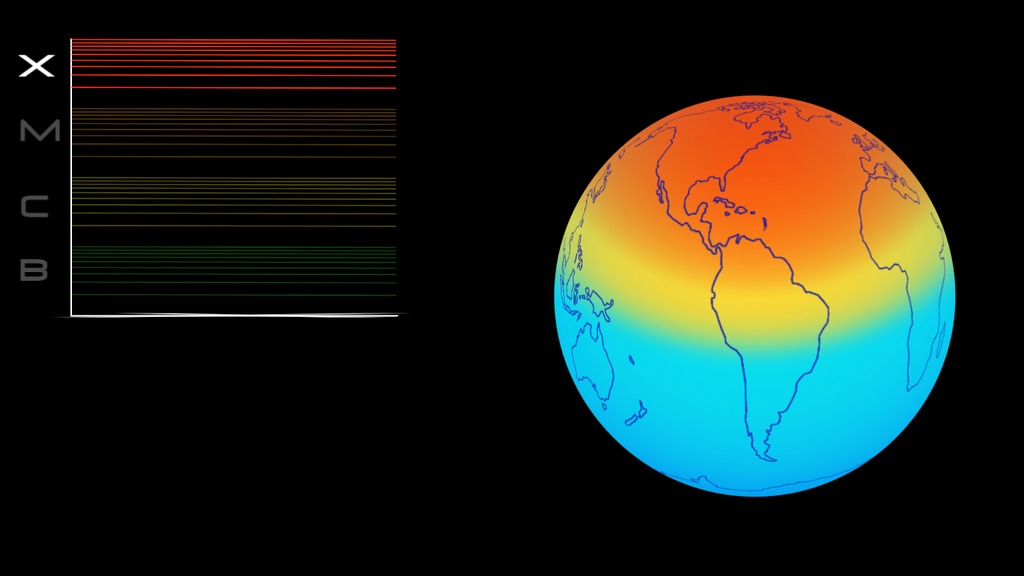First X-Class Solar Flares of 2013
On May 13, 2013, the sun emitted an X2.8-class flare, peaking at 12:05 p.m. EDT. This is the the strongest X-class flare of 2013 so far, surpassing in strength the X1.7-class flare that occurred 14 hours earlier. It is the 16th X-class flare of the current solar cycle and the third-largest flare of that cycle. The second-strongest was an X5.4 event on March 7, 2012. The strongest was an X6.9 on Aug. 9, 2011.
On May 12, 2013, the sun emitted a significant solar flare, peaking at 10 p.m. EDT. This flare is classified as an X1.7, making it the first X-class flare of 2013. The flare was also associated with another solar phenomenon, called a coronal mass ejection (CME) that can send solar material out into space. This CME was not Earth-directed.
The May 12 flare was also associated with a coronal mass ejection, another solar phenomenon that can send billions of tons of solar particles into space, which can affect electronic systems in satellites and on the ground. Experimental NASA research models show that the CME left the sun at 745 miles per second and is not Earth-directed, however its flank may pass by the STEREO-B and Spitzer spacecraft, and their mission operators have been notified. If warranted, operators can put spacecraft into safe mode to protect the instruments from solar material. There is some particle radiation associated with this event, which is what can concern operators of interplanetary spacecraft since the particles can trip computer electronics on board.
On May 12-13 the sun erupted with an X1.7-class and an X2.8-class flare as well as two coronal mass ejections, or CMEs, off the upper left side of the sun. Solar material also danced and blew off the sun in what's called a prominence eruption, both in that spot and on the lower right side of the sun. This movie compiles imagery of this activity from NASA's Solar Dynamics Observatory and from the ESA/NASA Solar Heliospheric Observatory.
Credit: NASA/SDO/ESA/SOHO
Music: "Long Range Cruise" by Lars Leonhard, courtesy of the artist and BineMusic.
For complete transcript, click here.

The sun erupted with an X1.7-class solar flare on May 12, 2013. This is a blend of two images of the flare from NASA's Solar Dynamics Observatory (SDO) — one image shows light in the 171 angstrom wavelength, the other in 131 angstroms.
Credit: NASA/SDO/AIA

The sun erupted with an X1.7-class solar flare on May 12, 2013. This is a blend of two images of the flare from NASA's Solar Dynamics Observatory (SDO) — one image shows light in the 171 angstrom wavelength, the other in 131 angstroms.
Credit: NASA/SDO/AIA

On May 13, 2013, an X2.8-class flare erupted from the sun – the strongest flare of 2013 to date. This image of the flare, shown in the upper left corner, was captured by NASA’s Solar Dynamics Observatory in light of 131 angstroms, a wavelength which is particularly good for capturing the intense heat of a solar flare and which is typically colorized in teal.
Credit: NASA/SDO

Four images from NASA’s Solar Dynamics Observatory of an X3.2-class flare from late at night on May 13, 2013. Starting in the upper left and going clockwise, the images show light in the 304, 335, 193 and 131 angstrom wavelengths. By looking at the sun in different wavelengths, scientists can view solar material at different temperatures, and thus learn more about what causes flares.
Credit: NASA/SDO/AIA

Four images from NASA’s Solar Dynamics Observatory of an X3.2-class flare from late at night on May 13, 2013. Starting in the upper left and going clockwise, the images show light in the 304, 335, 193 and 131 angstrom wavelengths. By looking at the sun in different wavelengths, scientists can view solar material at different temperatures, and thus learn more about what causes flares. Unlabeled version.
Credit: NASA/SDO/AIA

These pictures from NASA’s Solar Dynamics Observatory show the three X-class flares that the sun emitted in under 24 hours on May 12-13, 2013. The images show light with a wavelength of 131 angstroms, which is particularly good for showing solar flares and is typically colorized in teal.
Credit: NASA/SDO/AIA

These pictures from NASA’s Solar Dynamics Observatory show the three X-class flares that the sun emitted in under 24 hours on May 12-13, 2013. The images show light with a wavelength of 131 angstroms, which is particularly good for showing solar flares and is typically colorized in teal.
Credit: NASA/SDO/AIA

These images from NASA’s Solar Dynamics Observatory show four X-class flares emitted on May 12-14, 2013 – the first four X-class flares of 2013. Each panel is a blend of two images one showing light in the 171 angstrom wavelength and the other in 131 angstroms.
Credit: NASA/SDO/GSFC

These images from NASA’s Solar Dynamics Observatory show four X-class flares emitted on May 12-14, 2013 – the first four X-class flares of 2013. Each panel is a blend of two images one showing light in the 171 angstrom wavelength and the other in 131 angstroms. Unlabeled.
Credit: NASA/SDO/GSFC

These images from NASA’s Solar Dynamics Observatory show four X-class flares emitted on May 12-14, 2013 – the first four X-class flares of 2013. Each panel shows the flare in 131 angstrom light. Credit: NASA/SDO/GSFC

These images from NASA’s Solar Dynamics Observatory show four X-class flares emitted on May 12-14, 2013 – the first four X-class flares of 2013. Each panel shows the flare in 131 angstrom light. Unlabeled. Credit: NASA/SDO/GSFC

These images from NASA’s Solar Dynamics Observatory show four X-class flares emitted on May 12-14, 2013 – the first four X-class flares of 2013. Each panel shows the flare in 131 angstrom light. Credit: NASA/SDO/GSFC

These images from NASA’s Solar Dynamics Observatory show four X-class flares emitted on May 12-14, 2013 – the first four X-class flares of 2013. Each panel shows the flare in 131 angstrom light. Unlabeled. Credit: NASA/SDO/GSFC

NASA's Solar Dynamics Observatory captured this image of sunspot group AR 1748, associated with all 4 X class solar flares on May 15, 2013. The image shows a blend of HMI continuum (similar to visible light) and AIA 304 angstrom extreme ultraviolet.
Credit: NASA/SDO

SOHO LASCO C2 image of the May 13, 2013 associated CME.
Credit: ESA&NASA/SOHO

SOHO LASCO C2 view of CME associated with the X2.8 flare.
Credit: NASA&ESA/SOHO

SDO 304 angstrom image of prominence eruption. Cropped.
Credit: NASA/SDO
SDO 304 angstrom frames of May 13 flare and prominence eruption.
Credit: NASA/SDO
For More Information
Credits
Please give credit for this item to:
NASA's Goddard Space Flight Center. However, individual items should be credited as indicated above.
-
Animator
- Tom Bridgman (Global Science and Technology, Inc.)
-
Video editor
- Scott Wiessinger (USRA)
-
Producers
- Scott Wiessinger (USRA)
- Genna Duberstein (USRA)
-
Writer
- Karen Fox (ADNET Systems, Inc.)
Release date
This page was originally published on Monday, May 13, 2013.
This page was last updated on Wednesday, May 3, 2023 at 1:52 PM EDT.
Missions
This page is related to the following missions:Series
This page can be found in the following series:Tapes
The media on this page originally appeared on the following tapes:-
2013 Heliophysics Breaking News
(ID: 2013021)
Tuesday, December 31, 2013 at 5:00AM
Produced by - Robert Crippen (NASA)

